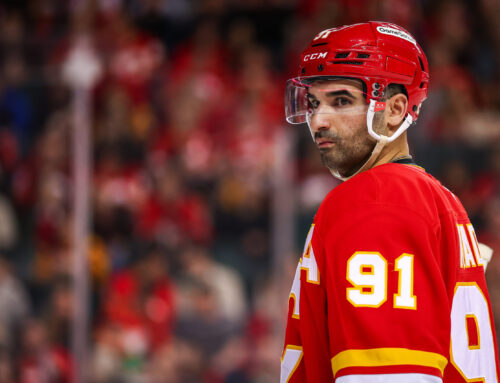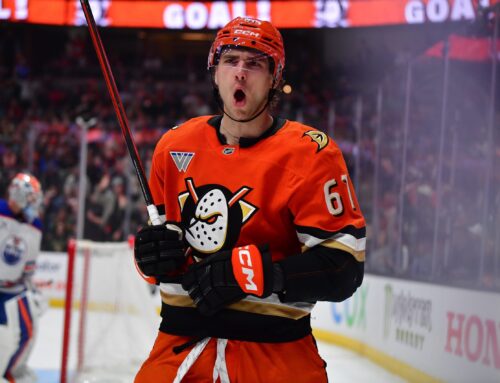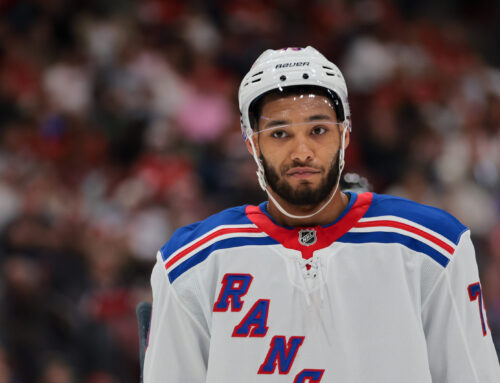With the regular season still fresh in our minds, this is a great opportunity to start using some recent numbers to think about next season. One practical way is to look at players who saw a significant decrease in shooting percentage this past campaign. Why is this so important? A player taking 200 shots that has a drop of five percentage points would see a decrease in 10 goals. That could be the difference between a 65-point keeper into a 55-point borderline drop.
There can be numerous reasons why a player might see a shooting percentage decrease. Maybe offseason moves pushed a player down the lineup with lesser-quality linemates. New coaches could mean new systems. An injury might impact the strength and quickness of a player’s shot, or an injured player might shy away from contact and not drive to the net like they once did.
The key is to figure out which players might rebound from that dip in shooting percentage.
Below are 10 players who saw a shooting percentage decline this season that you should be thinking about for next season.
Note, we’re only looking at forwards that have played a minimum of 40 games in each of the last two seasons and have seen their shooting percentage drop at least five percentage points. This means some of the popular names who had disappointing seasons (Chris Kreider and Jonathan Huberdeau, for example) are ruled out.
We’re also not going to include players who had extremely high shooting percentages in 2021-22. A significant drop would have been expected and you can’t count on a rebound for those players. For instance, many of the Predators fall into this boat. Filip Forsberg went from 18.6 per cent to 12.1, but the latter is a normal number for him. Same deal for Ryan Johansen, who went from 22 per cent to 14 per cent. Matt Duchene dropped from 18.9 to 13.1, which is still high for him as a Predator and matches his career shooting percentage.
Just missing the cut for this list? Nikita Kucherov, who saw his shooting percentage drop from 16 per cent to 11.1, and Alex DeBrincat, who dropped from 15.2 per cent to 10.3 per cent.
10. Yanni Gourde
Gourde is an example of a player who struggles when they are pushed down the lineup when new players come in. In Seattle’s inaugural season, Gourde scored 21 goals on a shooting percentage of 16.5 per cent. However, last offseason saw the Kraken add Andre Burakovsky and Oliver Bjorkstrand. This helped lead to less ice time and significantly fewer power-play minutes. He wound up scoring 14 goals on 9.9 per cent shooting this year. However, that 9.9 per cent is the second lowest of his career (his next lowest is 14.4 per cent). Even with the loss of ice time, it wouldn’t be a stretch to see him get back to the 20-goal mark again next season.
Truthfully, you’re not drafting Jeannot for his goal-scoring prowess. You’re looking to him for PIM and hits, and he’s dynamite in those two categories. Still, his 24 goals on a 19.4 shooting percentage as a rookie last year was a wonderful bonus. This year, his shooting percentage was almost a third of that, all the way down to 5.6 per cent. This helped lead to only six goals. Tampa Bay gave up a lot in a trade to get Jeannot, so they’ll be more anxious to prove it wasn’t a mistake next season. Expect him to get a bit more opportunity, perhaps taking over Corey Perry‘s role, next season.
8. Seth Jarvis
One tough thing about this kind of list is figuring out what is the norm for young players. Take Jarvis, for example. Is his normal the player who scored 17 goals on 110 shots (15.5 per cent) as a rookie two seasons ago? Or is his normal the sophomore that scored 14 goals on 187 shots (7.5 per cent) this year? The truth probably lies somewhere in the middle. However, considering this is a player who gets a normal shift with Sebastien Aho and has been on the top power-play unit in the postseason, expect that shooting percentage (and goal total) to rise next year.
After he teased us a year ago with a career-high 60-point season, Barbashev had a step back with a 45-point season this year. That’s still easily his second-best season ever, but it came with a significant drop in goals as he went from 26 to 16. Never a high-volume shooter (his 1.5 shots per game this year was a career high). Barbashev also saw his shooting percentage drop almost in half, from 23.4 per cent to 12.8 per cent. However, he did have a slight rebound in Vegas, where he shot 17.1 per cent in the regular season and 22.2 per cent in the postseason (before Sunday night’s contest). His success next year will depend on where he lines up. If he stays in Vegas and continues to play alongside Jack Eichel, expect a high shooting percentage and more goals. If he goes to a rebuilding team or somewhere he’ll be on the third line, don’t be surprised if there’s another dip.
Even though he netted a career-high 22 goals, it could have been even more if he was even close to his career average in shooting percentage. Just look at his numbers in his five seasons:
2018-19: 20 games, three goals, 18 shots, 16.7 per cent shooting percentage
2019-20: 27 games, three goals, 32 shots, 9.4 per cent shooting percentage
2020-21: 56 games, 17 goals, 111 shots, 15.3 per cent shooting percentage
2021-22: 46 games, 17 goals, 110 shots, 15.5 per cent shooting percentage
2022-23: 82 games, 22 goals, 249 shots, 8.8 per cent shooting percentage
He’s only played two full seasons so far (2020-21 was the 56-game Covid-shortened season, but it was his first full season), so there’s not a lot of history to go on. But before this season, he averaged a shooting percentage of 14.8 per cent. If he hit that threshold this season, he would have finished with 37 goals.
In 2021-22, Barkov potted a career-high 39 goals thanks to a career-high shooting percentage of 18.2 per cent. However, his shooting percentage this year of 11 per cent was too much of a market correction. That’s the third-lowest shooting percentage of his career and his lowest since 2017-18. Although he still averaged more than three shots per night, he dropped to 23 goals. Even a small movement back to his average will push his goal total back up next season. However, one thing about Barkov is how much of a Band-Aid boy he is. He hasn’t played more than 68 games since 2018-19 and has only played more than 72 games twice in his 10-year career.
A year ago, Lindholm had a career-high 42 goals on 17.9 per cent shooting and a career-high 2.9 shots per game. This year, that dropped to 22 goals on 11.8 per cent shooting and 2.3 shots per game. That 11.8 shooting percentage is his lowest of any season since joining the Flames five years ago. If he shot 16.3 per cent this year (that’s what he averaged in his first four years in Calgary), we’re talking about a 30-goal campaign for Lindholm. With Darryl Sutter out in Calgary, the offense should open up next year, and Lindholm should be one of the big beneficiaries.
Aside from his rookie season, Bertuzzi is generally known as a high-percentage shooter. In three of the last four previous seasons before this one, he finished around 16 per cent. The one season he didn’t was when he only played nine games but still finished at 25 per cent. That’s why this year’s shooting percentage of 7.5 per cent was out of character for him. That, combined with his drop of half a shot per game and missing 32 games due to injury, goes a long way to explaining why he didn’t reach the 10-goal mark. He did bounce back to a 23.8 per cent shooting percentage in the playoffs, but that was no help to anyone in fantasy hockey.
The Blue Jacket had a tough first year in Columbus, seeing a decrease in almost every relevant category (including a massive plunge in plus/minus from 64 to minus-32). He also dropped from 40 goals to 21, thanks to a drop in shooting percentage from 15.3 per cent to 9.8 per cent, and a decrease in shots per game from 3.2 to 2.8. That 9.8 shooting percentage is the second lowest in his nine-year career and his 0.26 goals per game is tied for the second lowest of his career, just slightly better than his 0.25 goals per game mark in 2016-17. If he shot what he averaged in Calgary of 12.9 per cent, he would have potted 28 goals. Those extra seven goals would have brought him to a point-per-game pace.
This year has to be considered slightly disappointing for anyone who drafted Matthews with a top-five pick last fall. He dropped from 60 goals to 40 and from 106 points to 86. His shots per game went from 4.8 to 4.4, and his shooting percentage dropped from 17.2 per cent to 12.2 per cent. This is the first time in his career that he failed to reach the teens in shooting percentage. Going into this season, he averaged a 16.4 shooting percentage per game. If he reached that mark this season, he would have potted 54 goals. Those extra 14 goals would have also pushed him to the 100-point mark.





 TOR
TOR EDM
EDM ANA
ANA PIT
PIT BUF
BUF S.J
S.J MIN
MIN DET
DET CBJ
CBJ UTA
UTA VAN
VAN
